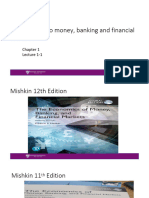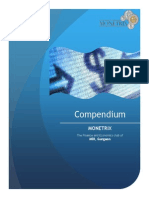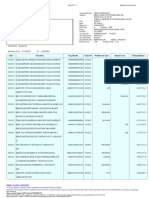0 ratings0% found this document useful (0 votes)
24 viewsPart - I: Introduction: Chapter 1: Why Study Financial Markets and Institutions?
Part - I: Introduction: Chapter 1: Why Study Financial Markets and Institutions?
Uploaded by
AKSHIT JAINThe document discusses why studying financial markets and institutions is important. It covers several key areas:
1) The importance of debt markets, stock markets, and foreign exchange markets. Fluctuations in exchange rates can impact both consumers and businesses.
2) The role of financial institutions like banks in connecting savers and investors. They help facilitate the flow of funds through the economy.
3) How monetary policy and money supply impact macroeconomic variables like GDP, inflation, and interest rates. Central banks use tools like interest rates to achieve economic goals.
Copyright:
© All Rights Reserved
Available Formats
Download as PPTX, PDF, TXT or read online from Scribd
Part - I: Introduction: Chapter 1: Why Study Financial Markets and Institutions?
Part - I: Introduction: Chapter 1: Why Study Financial Markets and Institutions?
Uploaded by
AKSHIT JAIN0 ratings0% found this document useful (0 votes)
24 views25 pagesThe document discusses why studying financial markets and institutions is important. It covers several key areas:
1) The importance of debt markets, stock markets, and foreign exchange markets. Fluctuations in exchange rates can impact both consumers and businesses.
2) The role of financial institutions like banks in connecting savers and investors. They help facilitate the flow of funds through the economy.
3) How monetary policy and money supply impact macroeconomic variables like GDP, inflation, and interest rates. Central banks use tools like interest rates to achieve economic goals.
Original Description:
mbfm lecture
Original Title
lecture 3
Copyright
© © All Rights Reserved
Available Formats
PPTX, PDF, TXT or read online from Scribd
Share this document
Did you find this document useful?
Is this content inappropriate?
The document discusses why studying financial markets and institutions is important. It covers several key areas:
1) The importance of debt markets, stock markets, and foreign exchange markets. Fluctuations in exchange rates can impact both consumers and businesses.
2) The role of financial institutions like banks in connecting savers and investors. They help facilitate the flow of funds through the economy.
3) How monetary policy and money supply impact macroeconomic variables like GDP, inflation, and interest rates. Central banks use tools like interest rates to achieve economic goals.
Copyright:
© All Rights Reserved
Available Formats
Download as PPTX, PDF, TXT or read online from Scribd
Download as pptx, pdf, or txt
0 ratings0% found this document useful (0 votes)
24 views25 pagesPart - I: Introduction: Chapter 1: Why Study Financial Markets and Institutions?
Part - I: Introduction: Chapter 1: Why Study Financial Markets and Institutions?
Uploaded by
AKSHIT JAINThe document discusses why studying financial markets and institutions is important. It covers several key areas:
1) The importance of debt markets, stock markets, and foreign exchange markets. Fluctuations in exchange rates can impact both consumers and businesses.
2) The role of financial institutions like banks in connecting savers and investors. They help facilitate the flow of funds through the economy.
3) How monetary policy and money supply impact macroeconomic variables like GDP, inflation, and interest rates. Central banks use tools like interest rates to achieve economic goals.
Copyright:
© All Rights Reserved
Available Formats
Download as PPTX, PDF, TXT or read online from Scribd
Download as pptx, pdf, or txt
You are on page 1of 25
Part – I : Introduction
Chapter 1: Why Study Financial
Markets and Institutions?
BITS Pilani
Recapitulation of the Last Class on 21st
August, 2020
• Why Study Financial Markets and Institutions?
– Debt Market and Interest rates
– The Stock Market
• Importance of interest rate in financial market
• Fluctuations and trend of interest rate
• Relationship between interest rate and economic growth
• Stock market trends and economic growth in India
• Supply leading and demand following hypothesis.
BITS Pilani, Pilani Campus
Why Study Financial Markets
and Institutions?
Why Study Financial Markets?
– Debt Market and Interest rates
– The Stock Market
– The Foreign Exchange market
• The Foreign exchange market is more volatile than the
Stock market.
• The causes of these volatility are many domestic and
international factors.
BITS Pilani, Pilani Campus
Why Study Financial Markets and Institutions?
The Foreign Exchange Market
• What have these fluctuations in exchange rate mean to
the public and business?
• A change in the exchange rate have a direct effect on
the consumer as it affect the cost of imports.
• When rupee depreciates, Indian consumer purchase
from foreign countries reduces, purchases of domestic
produced goods increases and various other direct
effects.
• Conversely, a strong rupee (rupee appreciation) means
exports reduces (as foreign consumer purchase from
India reduces) and hurts Indian business, reduces
production and employment.
BITS Pilani, Pilani Campus
Trend in Exchange rate wit US
Dollar (2003 to 2020)
BITS Pilani, Pilani Campus
Trend in Exchange rate wit US
Dollar (2003 to 2020)
BITS Pilani, Pilani Campus
Trend in Exchange rate wit US
Dollar (Last 5 Years)
BITS Pilani, Pilani Campus
Why Study Financial Markets and Institutions?
The Foreign Exchange Market
• The above figures states that rupee has depreciated
over these years with volatility.
• When rupee depreciates, it is expected that export
increases due to more demand from foreigners (foreign
imports increases) and hence export leading hypothesis
proved.
• When we look at the economic growth of India in past
decades, it is supporting the hypothesis at large.
• But both producer and consumer are not happy in the
short run.
BITS Pilani, Pilani Campus
Why Study Financial Markets and Institutions?
The Foreign Exchange Market
• But when rupee appreciates, Indian imports for foreign
goods become cheaper.
• Hence, parts and raw materials imports for the business
become affordable.
• Production of goods increases and possibly cost of
production decreases and hence price should become
cheaper ceteris paribus.
• In the long run both producer and consumer become
happy.
• As the foreign exchange market is becoming popular both
for Academics and financial investors, we will study this in
details in chapter 14 and 15
BITS Pilani, Pilani Campus
Why Study Financial Markets and Institutions?
Financial Institutions
• The second major focus of the course in Financial
Institutions.
• Financial institutions are what make financial markets
work.
• Without them, financial markets would not able to move
such a huge amount of funds from people who save to
people who have productive investment opportunities.
• Thus they play a crucial role in improving the productivity
and efficiency of the economy.
BITS Pilani, Pilani Campus
Why Study Financial Markets and Institutions?
Financial Institutions
• What we are dealing is the subject matter of Financial
Economics which studies;
1. Money and Banking
2. Financial Markets and Institutions
3. Monetary System
• Hence, Financial Economics studies The financial
System.
• What is Financial System?
BITS Pilani, Pilani Campus
Why Study Financial Markets and Institutions?
Financial Institutions
• Financial System includes:
1. Financial Institutions (Banks: Commercial Banks,
Central Bank, Investment Banks, Insurance companies)
2. Financial Markets (Stock Market)
3. Financial Instruments/ Financial Assets
• Financial Economics deals with how financial system
affects the economy (macro economy).
• What is all about Macro Economy?
BITS Pilani, Pilani Campus
Why Study Financial Markets and Institutions?
Financial Institutions
• We are going to study how Financial Institutions affect
the macroeconomic variables / system.
They includes;
• GDP (Output)
• Employment (Jobs)
• Wages (salary)
• Government Expenditures and Taxes
• Imports and Exports
• Interest rates
BITS Pilani, Pilani Campus
Structure of the Financial
System
– The financial system is complex comprising with
many different types of institutions.
– All are heavily regulated by the Government.
– Financial intermediaries are connecting institution
between savers and investors.
– Why are financial intermediaries are so crucial?
– Why do they give credit to one party and not to
others?
– Why do they have complicated legal documents?
– Why are they so heavily regulated?
BITS Pilani, Pilani Campus
Financial Institutions
• Financial institutions (intermediaries) that borrow funds
from people who have saved and make loans to other
people
• Banks—institutions that accept deposits and make
loans.
• Many Indian keep their savings in the form of saving
account and other types of bank deposits.
• Because banks are largest financial intermediaries in the
country, then deserve careful study.
BITS Pilani, Pilani Campus
Financial Institutions
• However, Banks are not only important financial
institutions.
• Indeed, in recent years, other financial institutions such
as insurance companies, financial companies, pension
funds,, mutual funds and investment banks have been
growing at the equal speed.
• Hence, they also needs careful study. We will study both
banks and other financial institutions in part 6 and 7 of
the book.
BITS Pilani, Pilani Campus
Monetary System
• Money referred as money supply is defined as anything that
is generally accepted as medium of exchange or means of
payment.
• Money is linked to changes in economic variables that effects
all of us and are important to the health of the economy.
• Evidence suggests that money
plays an important role in generating
business cycles
• Recessions (unemployment) and booms (inflation) affect all
of us
• Monetary Theory ties changes in the money supply to
changes in aggregate economic activity and the price level
BITS Pilani, Pilani Campus
Money growth and business
cycle
BITS Pilani, Pilani Campus
GDP and Inflation
BITS Pilani, Pilani Campus
Money and Inflation
• The aggregate price level is the
average price of goods and services in an economy
• A continual rise in the price level (inflation) affects all
economic players
• Data shows a connection between the money supply
and the price level
BITS Pilani, Pilani Campus
BITS Pilani, Pilani Campus
Macroeconomic Variables
interrelationships
• Interest rates are the price of money
• Prior to 1980, the rate of money growth and the interest
rate on long-term Treasure bonds were closely tied
• Since then, the relationship is less clear but still an
important determinant of interest rates
BITS Pilani, Pilani Campus
Macroeconomic Variables
interrelationships
BITS Pilani, Pilani Campus
What is the link between growth,
inflation and interest rates?
• In a fast-growing economy, incomes go up quickly and more
and more people have the money to buy the existing bunch
of goods. As more and more money chases the existing set
of goods, prices of such goods rise. In other words, inflation
(which is nothing but the rate of increase in prices) spikes.
• To contain inflation, a country’s central bank typically nudges
up the interest rates in the economy. By doing so, it
incentivizes people to spend less and save more because
saving becomes more profitable as interest rates go up. As
more and more people choose to save, money is sucked out
of the market and inflation rate moderates.
BITS Pilani, Pilani Campus
What happens when growth rate
decelerates or contracts?
• When growth contracts, as is happening in the current financial
year, or when its growth rate decelerates, as was happening
right through 2019, then typically, people’s incomes also get hit.
As a result, less and less money is chasing the same quantity of
goods. This results in either the inflation rate decelerating (that
is, prices grow at 1% instead of 5%; also called “disinflation”) or
it actually contracts (also called “deflation”; that is, prices
reduce by 1% instead of growing at 5%).
• In such situations, a central bank nudges down the interest
rates so as to incentivize spending and by that route boost
economic activity in the economy. Lower interest rates imply
that it is less profitable to keep one’s money in the bank or any
similar saving instrument. As a result, more and more money
comes into the market, thus boosting growth and inflation.
BITS Pilani, Pilani Campus
You might also like
- Virgin Media Ebill PDFDocument5 pagesVirgin Media Ebill PDFTHIMMAPPA100% (3)
- Debt Reduction Calculator V1.6Document3 pagesDebt Reduction Calculator V1.6brianfromboiseNo ratings yet
- HOBA - Practice SetDocument5 pagesHOBA - Practice SetCarl Dhaniel Garcia SalenNo ratings yet
- 704Document3 pages704Bhoomi GhariwalaNo ratings yet
- Statement 2020MTH01 65376297-UnlockedDocument4 pagesStatement 2020MTH01 65376297-UnlockedZaheda BegumNo ratings yet
- ECON F312: Money, Banking and Financial Markets I Semester 2020-21Document16 pagesECON F312: Money, Banking and Financial Markets I Semester 2020-21AKSHIT JAINNo ratings yet
- Part - I: Introduction: Chapter 2: Overview of The Financial SystemDocument26 pagesPart - I: Introduction: Chapter 2: Overview of The Financial SystemAKSHIT JAINNo ratings yet
- Econ F243: Macroeconomics ": BITS PilaniDocument20 pagesEcon F243: Macroeconomics ": BITS Pilanikaamayegiid69No ratings yet
- Ch-1 Banking and Financial Markets or Institutions & Financial System of BangladeshDocument20 pagesCh-1 Banking and Financial Markets or Institutions & Financial System of BangladeshiubregistrarofcNo ratings yet
- Financial SystemDocument15 pagesFinancial SystemRTushar BeeshmNo ratings yet
- CH 1 Why Study Money, BankingDocument15 pagesCH 1 Why Study Money, BankingLoving GamesNo ratings yet
- Why Study Money, Banking, and Financial Markets?Document12 pagesWhy Study Money, Banking, and Financial Markets?وائل مصطفىNo ratings yet
- Chap 1 IntroDocument15 pagesChap 1 Introraynold robbieNo ratings yet
- Lecture 1-1Document18 pagesLecture 1-1phidanedNo ratings yet
- Session On EconomyDocument48 pagesSession On EconomyhiteshaNo ratings yet
- The Economy and Securities Analysis - Business FinanceDocument45 pagesThe Economy and Securities Analysis - Business FinanceMark Angelo R. Arceo100% (1)
- BBA607 - Role of International Financial InstitutionsDocument11 pagesBBA607 - Role of International Financial InstitutionsSimanta KalitaNo ratings yet
- Relationship BTWN Inflation Exchange FluctuationDocument10 pagesRelationship BTWN Inflation Exchange FluctuationhajashaikNo ratings yet
- Why Study Money, Banking, and Financial Markets?Document28 pagesWhy Study Money, Banking, and Financial Markets?Joe PatrickNo ratings yet
- Notes 1 - Money and The Philippine Monetary SystemDocument10 pagesNotes 1 - Money and The Philippine Monetary SystemAnnabelle RicoNo ratings yet
- Why Study Money, Banking, and Financial Markets?Document29 pagesWhy Study Money, Banking, and Financial Markets?Lazaros KarapouNo ratings yet
- Assignment Day 3Document12 pagesAssignment Day 3Qazi MobeenNo ratings yet
- TOPIC VII: Bangko Sentral NG Pilipinas: Learning ObjectivesDocument8 pagesTOPIC VII: Bangko Sentral NG Pilipinas: Learning ObjectivesJoshua OrobiaNo ratings yet
- Final PaperDocument14 pagesFinal PaperNicole YabutNo ratings yet
- Session 1 An Introduction To Financial Markets and InstitutionsDocument16 pagesSession 1 An Introduction To Financial Markets and InstitutionsKrutarth PatelNo ratings yet
- ME Cycle 8 Session 8Document87 pagesME Cycle 8 Session 8OttilieNo ratings yet
- Fundamental Analysis in SAPMDocument6 pagesFundamental Analysis in SAPMRoshan VargheseNo ratings yet
- 04 - Chapter 1Document28 pages04 - Chapter 1shan23586No ratings yet
- ECON F243: Macroeconomics: BITS PilaniDocument22 pagesECON F243: Macroeconomics: BITS Pilanikaamayegiid69No ratings yet
- Week 1FMDocument52 pagesWeek 1FMchitkarashelly100% (1)
- Why Study Money, Banking, and Financial Markets?Document30 pagesWhy Study Money, Banking, and Financial Markets?Zəfər CabbarovNo ratings yet
- FPP1x - Slides Introduction To FPP PDFDocument10 pagesFPP1x - Slides Introduction To FPP PDFPranav Jain100% (1)
- A Project Report On A STUDY of EQUITY On CAPITAL MARKETS at Indian Infoline BengloreDocument101 pagesA Project Report On A STUDY of EQUITY On CAPITAL MARKETS at Indian Infoline BengloreBabasab Patil (Karrisatte)100% (1)
- Monetary Policy Upsc Notes 52Document5 pagesMonetary Policy Upsc Notes 52Yuseer AmanNo ratings yet
- Comparison of Emerging Economy Through Macro Economy IndicatorsDocument29 pagesComparison of Emerging Economy Through Macro Economy Indicatorssarangk87No ratings yet
- MFT - Chapter 1 Why Study Money Banking and Financial MarketsDocument24 pagesMFT - Chapter 1 Why Study Money Banking and Financial Marketshtamanh05.personalNo ratings yet
- GlobalizationDocument39 pagesGlobalizationAlexanderNo ratings yet
- Econ F243: Macroeconomics: BITS PilaniDocument24 pagesEcon F243: Macroeconomics: BITS Pilanikaamayegiid69No ratings yet
- Chapter 1.the Financial SystemDocument88 pagesChapter 1.the Financial SystemDimple EstacioNo ratings yet
- EconomicsDocument5 pagesEconomicspb_vgslNo ratings yet
- SAPM Unit-3Document31 pagesSAPM Unit-3Paluvayi SubbaraoNo ratings yet
- Econ - An Afternoon With Jim Rogers - 2009!02!04 Maybank-IB ETDocument3 pagesEcon - An Afternoon With Jim Rogers - 2009!02!04 Maybank-IB ETwonderwNo ratings yet
- International Financial System: By:-Vikram.G.B Lecturer, P.G. Dept. of Commerce V.D.C Bangalore-55Document40 pagesInternational Financial System: By:-Vikram.G.B Lecturer, P.G. Dept. of Commerce V.D.C Bangalore-55Ahlya GaurNo ratings yet
- Ch01 ME For BlackboardDocument17 pagesCh01 ME For BlackboardIlqar SəlimovNo ratings yet
- EcoDev Lesson 1 - Overview of Real World EconomicsDocument25 pagesEcoDev Lesson 1 - Overview of Real World EconomicsRias CrimsonNo ratings yet
- International Finance - Hons NotesDocument30 pagesInternational Finance - Hons NotesafeeftalhapcNo ratings yet
- MDI GWPI Prep - Monetrix ChapterDocument22 pagesMDI GWPI Prep - Monetrix ChapterAnand1832No ratings yet
- Capital MarketDocument36 pagesCapital Marketmayuri chaudhariNo ratings yet
- Winter 2017 BBA Semester 6 BBA603: Role of International Financial InstitutionsDocument10 pagesWinter 2017 BBA Semester 6 BBA603: Role of International Financial InstitutionsSujal SNo ratings yet
- Economic Issues PDFDocument10 pagesEconomic Issues PDFFathik FouzanNo ratings yet
- INDIAN CAPITAL MARKET Final09Document65 pagesINDIAN CAPITAL MARKET Final09Pravin DateNo ratings yet
- FMI Tanveer-FullDocument23 pagesFMI Tanveer-Full023- TARANNUM SHIREEN GHAZINo ratings yet
- Be NotesDocument11 pagesBe NotesAshutosh UtekarNo ratings yet
- Saravanan Brs U4 Session 7Document23 pagesSaravanan Brs U4 Session 7SaravananSrvnNo ratings yet
- Economy, Industry and Company Analysis - by S. KevinDocument9 pagesEconomy, Industry and Company Analysis - by S. KevinHaider100% (1)
- Impact of Various Policies of Financial MarketDocument12 pagesImpact of Various Policies of Financial MarketNeel KanakNo ratings yet
- Company's Shareholders: Chairperson's CEO's Auditor's Mission Statement Corporate GovernanceDocument5 pagesCompany's Shareholders: Chairperson's CEO's Auditor's Mission Statement Corporate GovernanceRoshanrvNo ratings yet
- International Financial SystemDocument39 pagesInternational Financial SystemthensureshNo ratings yet
- Money and Banking in The PhilippinesDocument36 pagesMoney and Banking in The PhilippinesMARCK JULLIAN ALFONSONo ratings yet
- Banko Sentral NG PilipinasDocument8 pagesBanko Sentral NG PilipinasJoshua OrobiaNo ratings yet
- How To Analyze The Stock MarketDocument9 pagesHow To Analyze The Stock MarketantumanipadamNo ratings yet
- Chapter 1 Why Study Financial Markets and InstitutionsDocument17 pagesChapter 1 Why Study Financial Markets and InstitutionsJay Ann DomeNo ratings yet
- L&T Mutual Fund: Built On Strong FoundationDocument23 pagesL&T Mutual Fund: Built On Strong FoundationReya GalaNo ratings yet
- Rational Market Economics: A Compass for the Beginning InvestorFrom EverandRational Market Economics: A Compass for the Beginning InvestorNo ratings yet
- Part - I: Introduction: Chapter 2: Overview of The Financial SystemDocument25 pagesPart - I: Introduction: Chapter 2: Overview of The Financial SystemAKSHIT JAINNo ratings yet
- ECON F312: Money, Banking and Financial Markets I Semester 2020-21Document23 pagesECON F312: Money, Banking and Financial Markets I Semester 2020-21AKSHIT JAINNo ratings yet
- EGD Project Topics PDFDocument2 pagesEGD Project Topics PDFAKSHIT JAINNo ratings yet
- EGD 1 Notes PDFDocument35 pagesEGD 1 Notes PDFAKSHIT JAINNo ratings yet
- CH - 02 Issue and Redemption of DebenturesDocument7 pagesCH - 02 Issue and Redemption of DebenturesMahathi AmudhanNo ratings yet
- Akuntansi Hotel MR PNDDocument6 pagesAkuntansi Hotel MR PNDsarasatiwanamiNo ratings yet
- Borrower'S Basic Fact Sheet For Corporate Prescribed Under Regulation R-3 1. Borrower'S ProfileDocument4 pagesBorrower'S Basic Fact Sheet For Corporate Prescribed Under Regulation R-3 1. Borrower'S ProfileAsadullah SherNo ratings yet
- Chapter 8 Unit 3 - UnlockedDocument16 pagesChapter 8 Unit 3 - UnlockedSanay ShahNo ratings yet
- 2.forensic Audit ReportDocument20 pages2.forensic Audit ReportChartered Accountant100% (1)
- Financial Markets and Instruments in GhanaDocument16 pagesFinancial Markets and Instruments in GhanaKwesi Banson Jnr100% (1)
- Havells India Limited: A Report On Financial Statement AnalysisDocument22 pagesHavells India Limited: A Report On Financial Statement Analysiswritik sahaNo ratings yet
- 4 ESO Academics - Unit 01 - Exercises 1.4.Document6 pages4 ESO Academics - Unit 01 - Exercises 1.4.GoheimNo ratings yet
- PartnershipDocument5 pagesPartnershipmky5r59xfnNo ratings yet
- ABM 003 Performance Task #1 (2G)Document8 pagesABM 003 Performance Task #1 (2G)Zoe LustivaNo ratings yet
- Date Narration Chq./Ref - No. Value DT Withdrawal Amt. Deposit Amt. Closing BalanceDocument15 pagesDate Narration Chq./Ref - No. Value DT Withdrawal Amt. Deposit Amt. Closing BalanceEathenNo ratings yet
- Mashreq Consolidated Financial Statements 2021 EnglishDocument179 pagesMashreq Consolidated Financial Statements 2021 EnglishHassan AliNo ratings yet
- Nri GpaDocument6 pagesNri GpaThomas MallavarapuNo ratings yet
- AMFI - Investor Awareness Presentation - Jul'23Document69 pagesAMFI - Investor Awareness Presentation - Jul'23padmaniaNo ratings yet
- Bouncing Checks Law and PDIC LawDocument14 pagesBouncing Checks Law and PDIC LawChiemy Atienza YokogawaNo ratings yet
- Chapter 23 The Effects of Changes in Foreign Exchange Rates Afar Part 2Document20 pagesChapter 23 The Effects of Changes in Foreign Exchange Rates Afar Part 2Kathrina RoxasNo ratings yet
- Khushboo Balani RMSDocument60 pagesKhushboo Balani RMSKhushboo BalaniNo ratings yet
- Dion Market Timing ModelDocument18 pagesDion Market Timing Modelxy053333100% (1)
- PSBank Home Loan Application Form - Properties For SaleDocument2 pagesPSBank Home Loan Application Form - Properties For SaleLeane Leandra SNo ratings yet
- Ujjivan Small Finance Bank LimitedDocument5 pagesUjjivan Small Finance Bank LimitedSaurav KumarNo ratings yet
- Pricing Calculator Excel Used in BanksDocument15 pagesPricing Calculator Excel Used in Banksrahul kr raiNo ratings yet
- Cal - of HarbirDocument1 pageCal - of Harbircommission sompoNo ratings yet
- Statement of Cash Flows: Mcgraw-Hill/IrwinDocument59 pagesStatement of Cash Flows: Mcgraw-Hill/IrwinMuhammad Shafay MalikNo ratings yet
- Journal EntryDocument1 pageJournal EntryFransiel B. AkistoyNo ratings yet
- 1 What Implications Do You Draw From The Graph ForDocument2 pages1 What Implications Do You Draw From The Graph ForAmit PandeyNo ratings yet





























































































